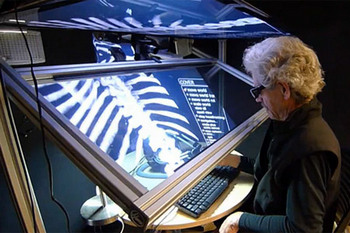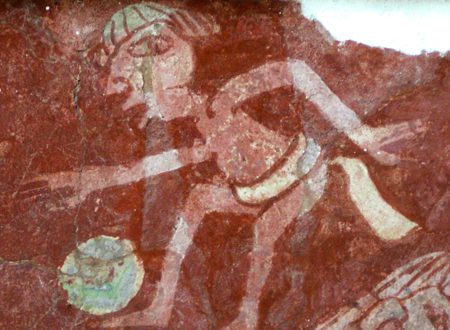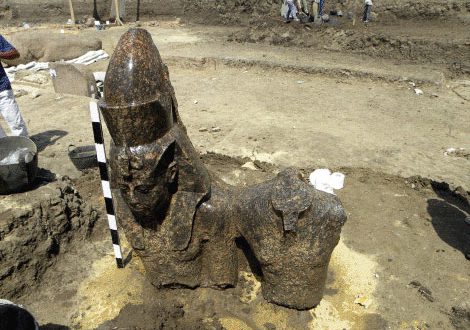 Archaeologists excavating a 9,000 square metre area at Angers, in the Loire District, France, have discovered the remains of the first mithraeum a sanctuary dedicated to the Indo-Iranian god Mithras in the west of France.
Archaeologists excavating a 9,000 square metre area at Angers, in the Loire District, France, have discovered the remains of the first mithraeum a sanctuary dedicated to the Indo-Iranian god Mithras in the west of France.
The cave sanctuary, a rectangular building, is dated to the third century AD.
The Mithraeum
The small, vaulted chapel in which worshippers hosted banquets and sacrifices dedicated to the god, is decorated with a starry sky.
The excavations revealed drums of columns perhaps statue bases, but possibly altars. A sort of vestibule allowed worshippers to don their ceremonial robes before entering the sanctuary.
The Mithraic Mysteries
It is believed the cult of Mithras was first introduced to the Roman Empire by soldiers coming from the East, somewhere at the end of the first century AD. Mithraism, a religion exclusive to men, first became popular with the elite, but quickly spread through all layers of society. Later it became known as a soldier’s cult. Shrines dedicated to Mithras are most often found at the borders of the Roman Empire, where large amounts of troops were stationed.
 Mithraism an individual religion, not a state cult, but itdid not conflict with the Imperial Cult (‘worshipthe Emperor’). Only later, when Mithraism became a competitor of early Christianity and despite, or maybe because certain similarities between both cults, the pagan religion was fiercely opposed. In 392 the cult was banned by Emperor Theodosius.
Mithraism an individual religion, not a state cult, but itdid not conflict with the Imperial Cult (‘worshipthe Emperor’). Only later, when Mithraism became a competitor of early Christianity and despite, or maybe because certain similarities between both cults, the pagan religion was fiercely opposed. In 392 the cult was banned by Emperor Theodosius.
The Tauroctony &Ex Voto Offerings
Mithraism was an initiation cult, its secrets passed through oral tradition. Today, the only written testimonies about the mysterious cult scholars have were written by early Christian authors, who concievedMithras asthe devil’s representation on earth. This limited perception of the historical sources, makes the archaeological record relating to the cult all the more valuable.
At the sanctuary, a typical bas-relief of the god Mithras wearing his Phrygian cap shows him slaughtering a bull the so-called tauroctony. The god’s face was damaged in ancient times, possibly by early Christians trying to suppress the pagan cult.
The excavations further revealed scenes displaying dadophoroi (torch bearers), and miles (spearmen). Marble lion paws, as well as a pieces of a dog statue were unearthed from the cave, but are heavily fragmented. Likely these too were intentionally destroyed. Evidence of a fire was found, but it can not be confirmedif thefire was set on purpose, aimed at destroying the pagan sanctuary.
Among the finds in and aroundtheTemple of Mithrasis a unique zoomorph vase, probably used in purification rituals (see thisINRAP video). Further artefacts discovered at the site includeoil lamps, fragmentsof a lampcontaining Nubian terracotta figures, a bronze 4th century crucifix fibula and about 200 coins.
 Large quantities of cockerel bones (a favoured dish at the cultic banquets) were found spread inside and around the ancient temple.
Large quantities of cockerel bones (a favoured dish at the cultic banquets) were found spread inside and around the ancient temple.
A ceramic beaker offered by a certain Genialis, in the first half of the 3rd century reads:
DEO [INVIC]TO MYTRH[AE]…/…]VS GENIALIS CIVES MA […]VS EXVOTO D[…/…]RIBVS OMNIS LOCO OMNIS (…)
To the unconquered god Mithras, Genialis, citizen of , offers in ex voto (this vase).
A cartouche containing four lines in Greek was found on a piece of carved limestone decorated with palm leaves. It was partially deciphered, and indicates a dedication was made by a man named Theophilos (of Eastern origin) for the benefit of Retituitos (a name of Gallic consonance).
An Antique Quarter
At the ancient settlement the INRAP archaeologists also unearthed the remains of two major urban roads; the cardo (north-south oriented street) and decumanus (east-west oriented) axes. The earliest evidence of occupationfound so far is dated to the beginning of Emperor Augustus‘ reign, around 10 BC.
At the end of the first century, one or two domus (Roman villas), complete with hypocaust (floor heating) were constructed on the site.
Angers in Roman times was a fairly small oppidum, a fortified settlement probably no bigger than 80 hectares at its height with some 3,000 inhabitants. Its name, Juliomagnus, means ‘the market of Julius Caesar’.
The ancient city had its own amphitheatre, accommodating about 6,000 spectators, and Roman baths. In the fifth century AD, Angers became known as ‘civitas Andecavorum’ or ‘Andecavis’, after its Gaul inhabitants.
Mithraic temples are common in the Roman Empire; although very unevenly distributed, with considerable numbers found in Rome, Ostia, Numidia, Dalmatia, Britain (Londinium and Carrawburgh) and along the Rhine & Danube frontiers; while being much less common in Greece, Egypt, and Syria.




